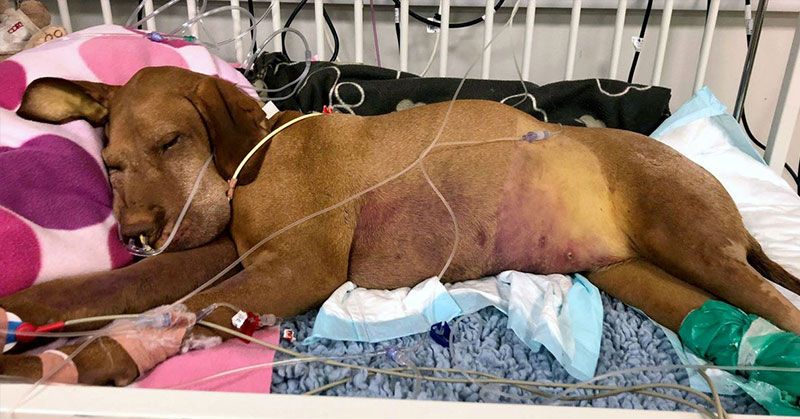Kate Chacksfield was at a loss when her dog Ruby became rapidly sick in less than a week. She took Ruby to the vet, and wracked her brain to figure out the source of this sudden ailment, but came up with nothing.
After Chacksfield paid almost $13,000 in medical bills, Ruby died. The cause of her death was the sweetener, Xylitol.
“I made brownies with Xylitol in to reduce the amount of sugar I was eating,” Chacksfield said.
Ruby had snuck and ate two of these brownies. Her owner didn’t bring her to medical care right away because she was unaware the sweetener was so harmful to dogs. Although chocolate is also toxic for dogs to eat, Ruby had snuck some brownies made with regular sugar in the past, and that amount of chocolate didn’t negatively affect her.
“I’ll get calls from people saying ‘My Great Dane just ate two M&Ms,’ but xylitol is far worse than chocolate,” says Dr. Tony Johnson, a clinical assistant professor at Purdue University College of Veterinary Medicine. [4]
“I had no idea how serious eating natural sweeteners was for dogs, the photos of her on life support still make me cry,” said Chacksfield, who had adopted Ruby when she was a puppy.
So far, she has used Ruby’s memory to spread awareness to other owners to be avoid feeding sweeteners to their dogs. It’s a little-known fact that Xylitol can cause low blood sugar, liver failure, seizures, and death for canines.
“It takes just a quarter of a teaspoon of sweetener to harm a dog,” she added.
When Chacksfield rushed Ruby to The Royal Veterinary College in London after the dog displayed signs of liver failure, it was already too late. If she had known about the dangers of the sweetener, Ruby may have survived the incident.
“We just thought she may have eaten some by mistake in the park or something—it never crossed my mind to mention the brownies,” she said. [6]
Why is Xylitol Harmful to Dogs?
Veterinary Toxicologist, Dr. Erik Dunayer, of the ASPCA predicted that “with the increased appearance of xylitol-sweetened products in the US, xylitol toxicosis in dogs may become more common.” And he was right.
In 2007, the ASPCA Animal Poison Control Center logged an average of less than five of these cases per day. In 2014, that number has doubled and is still rising. These numbers don’t include the logs from the Pet Poison Helpline and other hotlines, cases taken directly to animal ER or clinics, and the dogs unfortunately who don’t make it to the vet. [2]
While this sugar alcohol is harmless to most humans, it causes a rapid insulin release in dogs. This manifests in symptoms such as weakness, staggering, and vomiting, depending on the amount consumed. This can lead to seizures then liver damage or even brain trauma.
The full list of symptoms are as follows:
- Weakness or lethargy
- Depression
- Clotting problems
- Walking drunk
- Jaundiced gums
- Acute collapse
- Seizures
- A racing heart rate
- Black-tarry stool
- Trembling or tremoring
- Diarrhea
- Vomiting
- Bruising
- Abnormal mentation [5]
“Within 15 to 20 minutes, they might even be comatose,” says Ahna Brutlag, DVM, associate director of veterinary services at Pet Poison Helpline. [1]
How to Keep Xylitol Away from Dogs
Dog owners should check the ingredients of any sugar-free foods they buy, and if it contains xylitol, store it far from where their pet can access it. This sugar alcohol is added to many products, most commonly:
- Sugar-free gum and candies
- Protein bars
- Puddings
- Ketchup and other condiments
- Peanut butter
- Toothpaste and mouthwash
- Baked goods
- Lotions, gels, and deodorants
- Chewable vitamins and supplements
Other ways of protecting a dog from xylitol include:
- Being careful where you keep backpacks, purses, and other bags that contain gum or other such products. Don’t leave them where your pet can reach them. The safest place is on a secure hook, coat rack, or in a closed closet.
- If you bake with xylitol, be careful where you store the goods. Some dogs like to sneak food from the counters.
- If you brush your pet’s teeth, use only pet-safe toothpaste. Fluoride can also be toxic to them.
- Don’t allow your dog to scavenge when out on a walk. Maintain control over the leash or invest in a head collar. [2]
“[If your dog digests xylitol] you need to call your vet or the Pet Poison Helpline immediately,” says Brutlag. “Give them as much information as you can. Depending on the severity, they may suggest feeding [the dog] syrup or honey—something sweet to help keep their blood sugar up temporarily while you drive to seek emergency help.” [1]
Other Harmful Foods for Dogs
Besides Xylitol, other dangerous foods are:
- Chocolate
- Onions
- Garlic
- Grapes and raisins
- Macadamia nuts
- Avocados
- Caffeine
- Alcohol [3]
If a dog consumed or may have consumed one of these foods, take them to medical immediately.
- 6 Dangerous (and Surprising) Items That Contain Xylitol https://www.petmd.com/dog/emergency/poisoning-toxicity/6-dangerous-and-surprising-items-contain-xylitol
- Xylitol: The “sugar-free” sweetener your dog NEEDS you to know about https://www.preventivevet.com/dogs/xylitol-sugar-free-sweetener-dangerous-for-dogs
- 7 Human Foods That Can Be Fatal to Dogs https://www.healthline.com/nutrition/7-foods-fatal-to-dogs#section10
- Xylitol, the Deadly Sweetener Capable of Killing Your Dog Within 24 Hours https://www.poisonedpets.com/sugarless-gum-with-xylitol-the-toxic-bubble-poised-to-pop-on-your-pet-i-said-pop-not-poop/
- Xylitol Poisoning In Dogs: A Deadly Sugar Substitute https://www.pethealthnetwork.com/dog-health/dog-toxins-poisons/xylitol-poisoning-dogs-a-deadly-sugar-substitue
- Dog Owners Need to Watch Out For Xylitol: Dog Dies After Eating Brownies With Sugar Substitute https://www.health.com/syndication/xylitol-sugar-free-foods-toxic-to-dogs

